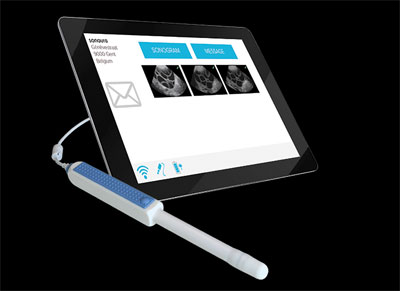DIY Vaginal Ultrasounds Could Reduce Trips to the Doctor

A new "do-it-yourself" ultrasound method could let women who are undergoing in vitro fertilization (IVF) cut down on their trips to the doctor's office, a new study suggests.
The technology allows these women to perform vaginal ultrasounds at home, while their doctor views the results from afar.
During IVF treatment, women are given hormones that trigger their ovaries to produce multiple eggs in one cycle. But although the hormone injections can be done at home, women need to visit the doctor frequently — sometimes five or six times over a two-week period — to monitor how well the treatment is working. They are given a vaginal ultrasound (in which an ultrasound probe is placed into the vagina) to view the ovaries, so the doctor can see whether the eggs are maturing.
The new study suggests it may be possible for women to perform these ultrasounds on themselves, at home. [Future of Fertility Treatment: 7 Ways Baby-Making Could Change]
In the study, 123 women in Belgium who were undergoing IVF were randomly assigned to either home monitoring, or the regular trips to the doctor's office. In the home monitoring group, women were given a laptop with imaging software and a vaginal probe with a USB connection. They were shown how to use the probe to take video recordings of their ovaries, and how to upload and send the videos to their doctor.

After taking an initial sonogram, women in the home monitoring group did not need to visit the doctor until their eggs were ready to be collected, while those in the regular care group made several doctor's visits.
Women in both groups had similar outcomes in terms of the number of eggs that doctors were able to retrieve and the number of fertilized eggs they were able to have implanted. About one-quarter of women in both groups became pregnant.
Sign up for the Live Science daily newsletter now
Get the world’s most fascinating discoveries delivered straight to your inbox.
And because women in the home monitoring group made fewer doctor's visits, they spent less money on transportation, and took less time off of work. Patients in the home monitoring group were also more satisfied with their treatment.
"Home monitoring … may provide a patient-centered alternative to the standard methods," the researchers, from Ghent University Hospital in Belgium, wrote in the July 3 issue of the journal Human Reproduction. "This approach offers several advantages for patients as well as care providers, including similar results to the traditional methods … and potentially bringing care to patients in poor resource settings."
The technology used in the study has been licensed to a company called Fertihome in Europe, and an affiliated company called Sonaura in the United States. The product is being used in about five centers in Europe, and Sonaura is currently seeking approval from the U.S. Food and Drug Administration to sell the product in the United States, said Patrick Bols, who represents Sonaura.
Bols said the product saves women time — some women who live far away from a fertility center have to travel hours just for a 2-minute sonogram, he said.
However, experts were skeptical about how widely home ultrasounds would be used in the United States.
Dr. Tomer Singer, a reproductive endocrinologist at Lenox Hill Human Reproduction fertility clinic in New York City, said that medicine in general is moving toward telemonitoring (using technology to monitor patients remotely), and that techniques for home monitoring will continue to evolve in the future.
But Singer said he would like to see more research on how the home monitoring technique fares in women who are at increased risk of developing painful and swollen ovaries as a side effect of the hormone drugs — a condition known as ovarian hyperstimulation syndrome. (One of the reasons that vaginal ultrasounds are performed is to prevent this syndrome.)
"I'm all in favor of doing monitoring at home; I just don't think that this study proves that doing it in all patients is feasible," Singer said.
In addition, he noted that many patients want the guidance medical professionals provide during office appointments — for instance, to tell them how well their treatment is working, and answer their questions. "If I were to give them [my patients] this option, I think less than 20 percent would chose that route," Singer said.
Dr. Avner Hershlag, chief of the Center for Human Reproduction at North Shore University Hospital in Manhasset, New York, agreed and said he felt American patients — who often have to pay for IVF treatment out-of-pocket — would have anxiety about doing the procedure themselves. "For them to feel that they can rely on their own monitoring, I think, is a big leap," Hershlag said.
Hershlag said that some clinics offer early-morning and late-evening appointments so that women don't have to miss work. Still, with more research, Singer said he thought certain groups of women could benefit from home monitoring, including those who live far away from their fertility clinic, those who've undergone IVF previously and those who are uncomfortable with a nurse or doctor inserting a vaginal probe.
Follow Rachael Rettner @RachaelRettner. Follow Live Science @livescience, Facebook & Google+. Original article on Live Science.

Rachael is a Live Science contributor, and was a former channel editor and senior writer for Live Science between 2010 and 2022. She has a master's degree in journalism from New York University's Science, Health and Environmental Reporting Program. She also holds a B.S. in molecular biology and an M.S. in biology from the University of California, San Diego. Her work has appeared in Scienceline, The Washington Post and Scientific American.
Is getting an IUD painful?
'Useless' female organ discovered over a century ago may actually support ovaries, study finds









